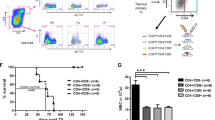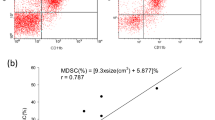Abstract
Spleen size ranks among the most important risk factors in chronic myeloid leukemia (CML), but the pathogenic mechanisms of splenic hematopoiesis in CML remain poorly defined. Here, we studied the biology of Bcr–Abl positive leukemia-initiating cells in the spleen, using an inducible transgenic mouse model of CML. Disease kinetics showed greater increases of immature leukemic cells in spleen vs bone marrow (BM). To assess how Bcr–Abl alters the behavior of spleen-derived CML cells, we transplanted these cells either before (‘pre-uninduced’) or 44 days after (‘pre-induced’) expression of the oncogene. Mice transplanted with pre-induced spleen cells showed significantly increased neutrophilia and splenomegaly compared with mice receiving pre-uninduced spleen cells, suggesting that Bcr–Abl expression in the donors had increased splenic tumor burden. However, pre-induction also altered the biology of these cells, as shown by a striking increase in erythropoietic potential. These results differ from those of BM-derived CML stem cells where pre-induction of Bcr–Abl had previously been shown to decrease disease transplantability. Moreover, splenic cells were less sensitive to imatinib than BM cells. In conclusion, Bcr–Abl alters the biology of splenic leukemic stem cells by a cell-autonomous mechanism, but the disease phenotype is also influenced by the microenvironment of these cells.
This is a preview of subscription content, access via your institution
Access options
Subscribe to this journal
Receive 12 print issues and online access
$259.00 per year
only $21.58 per issue
Buy this article
- Purchase on Springer Link
- Instant access to full article PDF
Prices may be subject to local taxes which are calculated during checkout





Similar content being viewed by others
References
Fialkow PJ, Jacobson RJ, Papayannopoulou T . Chronic myelocytic leukemia: clonal origin in a stem cell common to the granulocyte, erythrocyte, platelet and monocyte/macrophage. Am J Med 1977; 63: 125–130.
Takahashi N, Miura I, Saitoh K, Miura AB . Lineage involvement of stem cells bearing the philadelphia chromosome in chronic myeloid leukemia in the chronic phase as shown by a combination of fluorescence-activated cell sorting and fluorescence in situ hybridization. Blood 1998; 92: 4758–4763.
Druker BJ, Guilhot F, O′Brien SG, Gathmann I, Kantarjian H, Gattermann N et al. Five-year follow-up of patients receiving imatinib for chronic myeloid leukemia. N Engl J Med 2006; 355: 2408–2417.
Kantarjian H, Giles F, Wunderle L, Bhalla K, O′Brien S, Wassmann B et al. Nilotinib in imatinib-resistant CML and Philadelphia chromosome-positive ALL. N Engl J Med 2006; 354: 2542–2551.
Talpaz M, Shah NP, Kantarjian H, Donato N, Nicoll J, Paquette R et al. Dasatinib in imatinib-resistant Philadelphia chromosome-positive leukemias. N Engl J Med 2006; 354: 2531–2541.
O’Hare T, Eide CA, Deininger MW . Bcr-Abl kinase domain mutations, drug resistance, and the road to a cure for chronic myeloid leukemia. Blood 2007; 110: 2242–2249.
Bhatia R, Holtz M, Niu N, Gray R, Snyder DS, Sawyers CL et al. Persistence of malignant hematopoietic progenitors in chronic myelogenous leukemia patients in complete cytogenetic remission following imatinib mesylate treatment. Blood 2003; 101: 4701–4707.
Copland M, Hamilton A, Elrick LJ, Baird JW, Allan EK, Jordanides N et al. Dasatinib (BMS-354825) targets an earlier progenitor population than imatinib in primary CML but does not eliminate the quiescent fraction. Blood 2006; 107: 4532–4539.
Jorgensen HG, Allan EK, Jordanides NE, Mountford JC, Holyoake TL . Nilotinib exerts equipotent antiproliferative effects to imatinib and does not induce apoptosis in CD34+ CML cells. Blood 2007; 109: 4016–4019.
Schemionek M, Elling C, Steidl U, Baumer N, Hamilton A, Spieker T et al. BCR-ABL enhances differentiation of long-term repopulating hematopoietic stem cells. Blood 2010; 115: 3185–3195.
Corbin AS, Agarwal A, Loriaux M, Cortes J, Deininger MW, Druker BJ . Human chronic myeloid leukemia stem cells are insensitive to imatinib despite inhibition of BCR-ABL activity. J Clin Invest 2010; 121: 396–409.
Goh HG, Kim YJ, Kim DW, Kim HJ, Kim SH, Jang SE et al. Previous best responses can be re-achieved by resumption after imatinib discontinuation in patients with chronic myeloid leukemia: implication for intermittent imatinib therapy. Leuk Lymphoma 2009; 50: 944–951.
Rousselot P, Huguet F, Rea D, Legros L, Cayuela JM, Maarek O et al. Imatinib mesylate discontinuation in patients with chronic myelogenous leukemia in complete molecular remission for more than 2 years. Blood 2007; 109: 58–60.
Mahon FX, Rea D, Guilhot J, Guilhot F, Huguet F, Nicolini F et al. Discontinuation of imatinib in patients with chronic myeloid leukaemia who have maintained complete molecular remission for at least 2 years: the prospective, multicentre Stop Imatinib (STIM) trial. Lancet Oncol 2010; 11: 1029–1035.
Collins RK, Jackson JF, Morrison FS, Meydrech EF . Spleen size and chromosome analysis as prognostic factors in chronic myelogenous leukemia. South Med J 1979; 72: 642–644, 651.
Sokal JE, Cox EB, Baccarani M, Tura S, Gomez GA, Robertson JE et al. Prognostic discrimination in ‘good-risk’ chronic granulocytic leukemia. Blood 1984; 63: 789–799.
Hasford J, Ansari H, Pfirrmann M, Hehlmann R . Analysis and validation of prognostic factors for CML. German CML Study Group. Bone Marrow Transplant 1996; 17 (Suppl 3): S49–S54.
Hasford J, Pfirrmann M, Hehlmann R, Allan NC, Baccarani M, Kluin-Nelemans JC et al. A new prognostic score for survival of patients with chronic myeloid leukemia treated with interferon alfa. Writing Committee for the Collaborative CML Prognostic Factors Project Group. J Natl Cancer Inst 1998; 90: 850–858.
Hasford J, Baccarani M, Hoffmann V, Guilhot J, Saussele S, Rosti G et al. Predicting complete cytogenetic response and subsequent progression-free survival in 2060 patients with CML on imatinib treatment: the EUTOS score. Blood 2011; 118: 686–692.
Koschmieder S, Gottgens B, Zhang P, Iwasaki-Arai J, Akashi K, Kutok JL et al. Inducible chronic phase of myeloid leukemia with expansion of hematopoietic stem cells in a transgenic model of BCR-ABL leukemogenesis. Blood 2005; 105: 324–334.
Gomez GA, Sokal JE, Mittelman A, Aungst CW . Splenectomy for palliation of chronic myelocytic leukemia. Am J Med 1976; 61: 14–22.
Spiers AS, Baikie AF, Galton DA, Richards HG, Wiltshaw E, Goldman JM et al. Chronic granulocytic leukaemia: effect of elective splenectomy on the course of disease. Br Med J 1975; 1: 175–179.
Zhang B, Ho YW, Huang Q, Huettner C, Bhatia R . Altered Niche Interactions of Leukemia Stem Cells In a Chronic Phase Chronic Myelogenous Leukemia (CML) Transgenic Mouse Model. ASH Annu Meet Abstr 2010; 116: 1212.
Teoh M, Narayanan P, Moo KS, Radhakrisman S, Pillappan R, Bukhari NI et al. HPLC determination of imatinib in plasma and tissues after multiple oral dose administration to mice. Pak J Pharm Sci 2010; 23: 35–41.
Sjogren U, Brandt L . Different composition and mitotic activity of the haemopoietic tissue in bone marrow, spleen and liver in chronic myeloid leukaemia. Acta Haematol 1976; 55: 73–80.
Li S, Ilaria Jr RL, Million RP, Daley GQ, Van Etten RA . The P190, P210, and P230 forms of the BCR/ABL oncogene induce a similar chronic myeloid leukemia-like syndrome in mice but have different lymphoid leukemogenic activity. J Exp Med 1999; 189: 1399–1412.
Chalandon Y, Jiang X, Hazlewood G, Loutet S, Conneally E, Eaves A et al. Modulation of p210(BCR-ABL) activity in transduced primary human hematopoietic cells controls lineage programming. Blood 2002; 99: 3197–3204.
Kvasnicka HM, Thiele J, Schmitt-Graeff A, Diehl V, Zankovich R, Niederle N et al. Prognostic impact of bone marrow erythropoietic precursor cells and myelofibrosis at diagnosis of Ph1+ chronic myelogenous leukaemia--a multicentre study on 495 patients. Br J Haematol 2001; 112: 727–739.
Sengupta A, Arnett J, Dunn S, Williams DA, Cancelas JA . Rac2 GTPase deficiency depletes BCR-ABL+ leukemic stem cells and progenitors in vivo. Blood 2010; 116: 81–84.
Morita Y, Iseki A, Okamura S, Suzuki S, Nakauchi H, Ema H . Functional characterization of hematopoietic stem cells in the spleen. Exp Hematol 2010; 39: 351–359.e3.
Hariharan IK, Adams JM, Cory S . bcr-abl oncogene renders myeloid cell line factor independent: potential autocrine mechanism in chronic myeloid leukemia. Oncogene Res 1988; 3: 387–399.
Jiang X, Lopez A, Holyoake T, Eaves A, Eaves C . Autocrine production and action of IL-3 and granulocyte colony-stimulating factor in chronic myeloid leukemia. Proc Natl Acad Sci USA 1999; 96: 12804–12809.
Acknowledgements
This work was supported by grants from the German Research Foundation (DFG Kos 2155/2-2) and Innovative Forschung Münster (IMF KO 1 2 08 19).
Author information
Authors and Affiliations
Corresponding author
Ethics declarations
Competing interests
SK has received research support from Novartis (however, not for the research described here) and has served on advisory boards of Novartis and Bristol Myers Squibb.
Additional information
Supplementary Information accompanies the paper on the Leukemia website ()
Supplementary information
Rights and permissions
About this article
Cite this article
Schemionek, M., Spieker, T., Kerstiens, L. et al. Leukemic spleen cells are more potent than bone marrow-derived cells in a transgenic mouse model of CML. Leukemia 26, 1030–1037 (2012). https://doi.org/10.1038/leu.2011.366
Received:
Revised:
Accepted:
Published:
Issue Date:
DOI: https://doi.org/10.1038/leu.2011.366
Keywords
This article is cited by
-
Adverse outcomes for chronic myeloid leukemia patients with splenomegaly and low in vivo kinase inhibition on imatinib
Blood Cancer Journal (2023)
-
Splenic red pulp macrophages provide a niche for CML stem cells and induce therapy resistance
Leukemia (2022)
-
Therapeutic inhibition of FcγRIIb signaling targets leukemic stem cells in chronic myeloid leukemia
Leukemia (2020)
-
Infliximab therapy together with tyrosine kinase inhibition targets leukemic stem cells in chronic myeloid leukemia
BMC Cancer (2019)
-
Stem cell persistence in CML is mediated by extrinsically activated JAK1-STAT3 signaling
Leukemia (2019)



